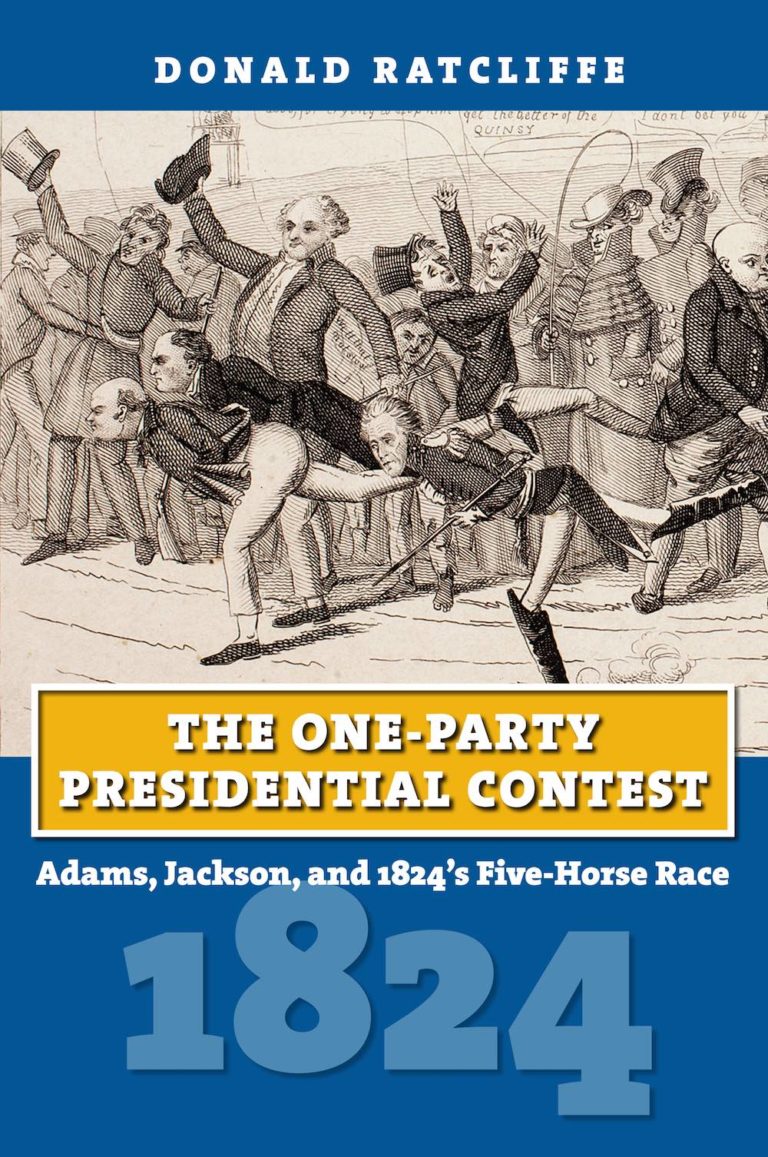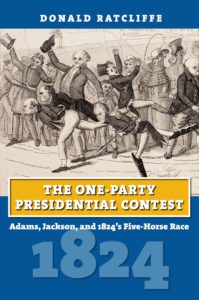A Not-So-Corrupt Bargain

After more than 225 years and fifty-seven presidential elections since the nation’s founding, there have been remarkably few contests in which large portions of the population questioned the accuracy and fairness of the results. Only during the elections of 1824, 1876, 1888, and 2000 did the candidate who won the popular vote ultimately lose the Electoral College vote amid accusations of voter fraud (1876), miscounting of ballots (1876 and 2000), and corrupt back-room bargains (1824 and 1876). (Although sitting president Grover Cleveland tallied slightly more votes than his Republican challenger Benjamin Harrison in 1888, Harrison’s lopsided victory in the Electoral College left people questioning the system, but not the results.) Yet because these episodes are so rare, and the stories of intrigue and corruption so captivating, the details of these elections have become ingrained as part of the meta-narrative of American history.
For example, we all know that the election of 1824 was the contest when the only political party left standing from the first party system failed to settle on just one nominee, resulting in a five-man race among political insiders (John Quincy Adams and William Crawford), emerging stars (Henry Clay and John C. Calhoun), and a popular general (Andrew Jackson). In an election in which voters increasingly asserted their voice at the polls, marking the emergence of full-blown white, male democracy, Jackson won a plurality of the popular and Electoral College votes, yet not the Electoral College majority required by the Constitution. With the election now in the hands of the House of Representatives, where each state delegation would have an equal vote, Clay redirected his supporters to vote for Adams, handing him the White House. When Adams later chose Clay as his secretary of state, the traditional stepping-stone to the presidency, rumors of a “corrupt bargain” between Adams and Clay were seemingly confirmed. Jackson’s supporters immediately began campaigning for his 1828 election, using this corrupt bargain that stole the presidency from the people’s choice as their rallying cry.
Donald Ratcliffe’s new book, The One-Party Presidential Contest: Adams, Jackson, and 1824’s Five-Horse Race, seeks to challenge key elements of this narrative that has been heavily influenced by what came after—the rise of Andrew Jackson, the creation of the Democratic Party, and the emergence of the second party system. The first half of the book presents the main characters and issues of the election. As I read this book in the midst of yet another presidential election cycle, it was nearly impossible not to find strong parallels between these figures and our own presidential candidates. There was the frontrunner, John Quincy Adams (Hillary Rodham Clinton)—an extremely qualified politician from a political dynasty who had served ably as secretary of state, and who yet was widely distrusted and disliked. Easily “the most distinguished candidate in the field,” he “was a divisive figure”; many “regarded him as most unsuitable and looked around for alternatives” (59). One potential alternative was DeWitt Clinton (Bernie Sanders), the popular New York politician who had little sense of party loyalty, instead publicly criticizing President Monroe and charting “his independent political course” (72). As the force behind the construction of the Erie Canal, he “symboliz[ed] both positive government and the decline of party spirit.” DeWitt Clinton received nominations in several states, and there were continued calls for him to run throughout the campaign. Although he ultimately declined to join the fray, Clinton’s popularity and potential to disrupt the race “dictated the strategy of others” (73).
The establishment wing of the Democratic Republicans, represented by supporters of the Congressional Caucus, believed early on that Secretary of the Treasury William Crawford (Jeb Bush) was the strongest candidate and “the man to beat” (25). He had come extremely close to snagging the party’s nomination from James Monroe in 1816, and by the 1820s was a leader of the party’s growing neo-antifederalist wing, who actively rejected national government policies such as protective tariffs and internal improvements. Yet despite the early buzz about his dominance of the field, Crawford’s candidacy failed to catch fire. A stroke in September 1823 and lingering questions about his health probably didn’t help his cause, but even more damning was the growing belief that his selection by the Congressional Caucus was an attempt by party elites to subvert the will of the people in selecting the next president; “to be hailed as the presidential choice of local political leaders was not necessarily an advantage” (110).
The populace seemed to be seeking an outsider who would bring fresh blood and ideas to the White House. Initially, this seemed to offer an opening to members of the new generation of politicians such as Henry Clay and John C. Calhoun (Ted Cruz and Marco Rubio), young men with more limited political experience but filled with presidential ambition. Yet before either could fully win the heart and soul of the party, Andrew Jackson (Donald Trump)—a true political outsider—stepped into this already crowded field. Although he was a nationally renowned figure due to his heroics at the Battle of New Orleans during the War of 1812, few people initially took his candidacy seriously, viewing it instead as a “diversion” due to his “hot-headedness and apparent lack of political judgment” (116-117). Jackson was able to tap into the pervasive belief that “Washington’s corruption…overwhelm[ed] all who went there” and that “Washington needed ‘the pure eye of a Patriot stranger’ to ‘discern abuses’ and ‘correct and purge them’” (141).
Although there is little new about these five candidates, Ratcliffe adds texture by discussing the impact of important almost-rans like William Lowndes and DeWitt Clinton, as well as the political calculations of Martin Van Buren. Yet whereas many histories focus mainly on the individuals, Ratcliffe insists that this election was ultimately about issues and not personalities. By immersing the reader in the details of the election itself—on a state-by-state and even county-by-county level—the second half attempts to strip away all of the post-1824 historical baggage that now colors this story to show how growing rifts over slavery and internal improvements dominated the discourse. Additionally, he uses this close reading of politics on the ground to demonstrate that the movement away from deferential politics and toward a strong sense of democracy was already well under way by the election of 1824, long before Jackson became its symbolic champion.
Finally, Ratcliffe changes the punch line of the story. Adams, not Jackson, won the popular vote; Adams was the natural second choice for Clay’s supporters; and there is no evidence that Clay and Adams ever struck any bargain—either explicit or implied. The standard popular vote figures only include the eighteen states where the people voted directly for the presidential electors, and these totals give Jackson an edge over Adams of about 25,000 votes. The popular vote in the remaining six states is traditionally not included in these figures, since the legislators still chose the electors, yet Ratcliffe (in a separate 2014 article) has interpolated what those votes would be. (Quite frustratingly, his methods for coming up with these alternative numbers are not included, although the estimated popular vote numbers are in the book.) Key to this discussion is New York, which contained 15 percent of the nation’s population. Jackson was not a contender in New York, with Adams, Crawford, and Clay battling it out for the critical thirty-six electoral votes. Regardless of the methods of calculation, it is not hard to be convinced that including New York in the popular vote numbers easily tips the balance in Adams’s favor. Ratcliffe also convincingly demonstrates the lack of evidence for a corrupt bargain, and why Clay supporters logically would have favored Adams over Jackson, particularly those Kentucky and Ohio delegations most interested in internal improvements.
This book is unquestionably the most complete, detailed work on the election of 1824. And it will absolutely change several of my slides on the 1820s. Where it is most successful is in demonstrating the importance of slavery and internal improvements as real issues dividing the nation and driving many presidential choices in 1824; he is less convincing about ethnicity, the protective tariff, and lingering effects of the Panic of 1819. But personality also still mattered. The unpopularity of Adams certainly cost him support, while the popularity of Jackson gained him votes despite his lack of clear policy stances on the main issues. And whereas the book is a constructive rethinking of the period, it doesn’t actually challenge the basic premise of the meta-narrative. While it is extremely useful for historians to be able to assess the comparative popularity of Adams and Jackson, and to know that Adams most likely had the most nationwide support, how much does it matter if contemporaries were unaware of this? Jackson’s supporters were quickly able to spin the results as electoral robbery, using the available voting returns and Electoral College results as their evidence. Without the counter-evidence of 2015, Adams’s supporters were powerless to alter this narrative. And even if we can today clear Clay’s tarnished name from participation in any corrupt bargain, is that more important than the fact that this belief dogged him for the remainder of his political career? So while Ratcliffe certainly is on solid ground in correcting the historical record and rereading 1824 without a post-1824 bias, he should not trade one anachronism for another—the knowledge that contemporaries lacked of national voter preferences and Clay’s true actions.
This article originally appeared in issue 16.4 (September, 2016).
Sharon Ann Murphy is professor of history at Providence College. She is the author of Investing in Life: Insurance in Antebellum America (2010), winner of the 2012 Hagley Prize for the best book in business history, and the forthcoming book Other People’s Money: How Banking Worked in the Early American Republic (Johns Hopkins University Press, 2016). Her latest projects are an investigation of the public perception of banks around the Panic of 1819, and an examination of the relationship between southern banks and American slavery.
